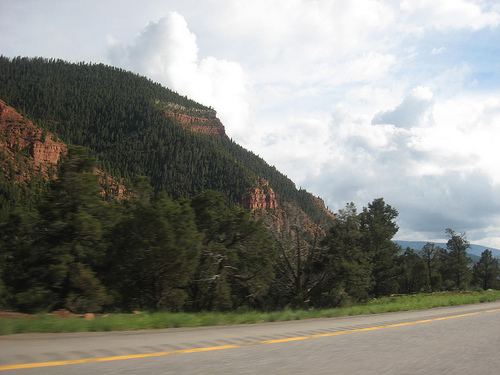Rural car accidents may prove more fatal
A recent investigation into 10 years of car accident data provided by the Colorado Department of Transportation suggests that accidents occurring in rural areas are more fatal than those occurring in more urban zones. The investigation, led by I-News at Rocky Mountain PBS, analyzed the decade of traffic fatality information and contrasted it with the average population in each county over ten years to “calculate a rate equal to the number of deaths per 10,000 residents in road crashes.” The five counties with the top fatality rates are remote, small areas (in fact, two of the counties have less than 1,000 residents). The counties with the lowest car accident fatality rates are located in the busy metro area.

An accident here is much more likely to be fatal than one that happens in downtown Denver. From Chelsea Marti.
There’s more: The National Highway Traffic Safety Administration recently released a report stating that in 2011, 55 percent of road crash fatalities were in rural areas – though just 19 percent of the population lived in such areas. (For instance, in Colorado, 51 percent of the fatalities were on country roads, according to the report.) In that state, the difference between rural and urban can mean the difference between life and death.
The stark contrast is due in part to the area’s geography, to the location of emergency care (near major metro areas), to the fact that volunteers – who may be less experienced – often serve rural areas, and to what I-News terms “local control,” which is related to how and where “local officials figure out how best to care for those who suffer life-threatening traumatic injuries.”
What happens when a driver gets into a potentially fatal crash outside the city limits in rural Colorado? In some areas, such as Poudre Canyon, which can be found west of Ft. Collins, CO, there is no cell phone service, so the driver and/or passenger first must find a phone. Certain volunteers in the area are close enough to respond to the emergency within, at most, a half hour, according to Bill Sears, president of the board of Poudre Canyon Fire Protection District.
Minutes count during emergencies; so does quality of care. As reported by I-News, Colorado and California are the country’s two states whose counties license ambulance services; so the ambulance system is operated by 225 organizations and 11 regional councils. With such a fractured system, it’s no wonder that many EMTs, especially those serving rural areas, may work with as few as 150-200 hours of training– compared to the paramedics who work for the Denver area ambulances, with a 1,500-hour minimum.

A crash here is much more survivable due to the proximity of emergency services – and crashes are rarer, perhaps because urban drivers are on their guard. From dolescum.
However, the fatality rate cannot only be attributed to response time, proximity to a hospital, or quality of care. Often, those who die in traffic accidents in rural areas are found to be dead on arrival. “It didn’t matter how close they were to a hospital, they weren’t going to survive,” State Patrol Trooper Jonathan Silver–who says higher speed limits, narrow and curved roads, infrequent seatbelt use, and fewer guardrails and barriers that separate traffic are the cause–told I-News. “You’re dealing with rollovers and head-on crashes, and those are primarily the big killers that I deal with,” he told I-News.
Plus, urban areas have fixed traffic regulation, slower speeds, and perhaps a slightly more intangible factor at play: Rural drivers may feel more secure because of the lessened traffic, while urban drivers may be more aware of the dangers of the road. That erroneous sense of security, compounded by rural areas’ inability to provide adequate emergency services, can and do often result in life-or-death consequences.
Category: Automotive, Resources, Road safety

















